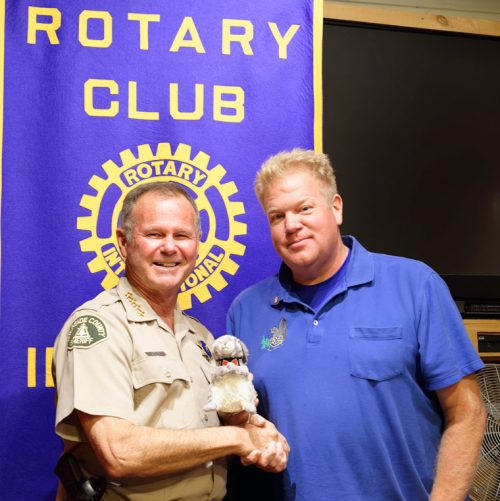
Riverside County Sheriff Stan Sniff was the invited speaker at the Idyllwild Rotary Club weekly meeting on Wednesday, Aug. 8. Although he is up for re-election in November, he was careful to avoid any semblance of campaigning, prohibited by law and departmental regulations when in uniform.
Nevertheless, he is proud of his department and what has been accomplished during his 11-year stint as sheriff and was not reticent to share these, along with an insight into the challenges his position presents. It must be noted that he is also proud to be a Rotarian in the Riverside East Club.
The Riverside County Sheriff’s Department is the fourth-largest of 58 in California, and it operates one of 39 training centers, in its case a joint one that offers police, fire and paramedic training. The police training course lasts for six months and is followed by an extensive period of on-the-job supervision.
With more than 4,000 employees, and a yearly attrition rate of 5 percent, there is a continuous need for new recruits to man the 10 individual stations and five jails within the county.
The department provides primary law enforcement for 17 of the 28 municipalities within the county, as well as 400,000 of the citizens who live in unincorporated areas, out of a total population of 2.8 million. That works out to 2,000 officers patrolling 7,300 square miles, with the Hemet Station alone responsible for 800 square miles.
Budget constraints mean that two or three deputies are out at any one time, part of the reality that living in a rural area requires. While that may be slim, the entire budget of the department, about $700 million per year, leaves little room for expansion.
In addition to patrol responsibilities, the department has responsibility as the coroner (not to worry — they also employ forensic pathologists), staffing of the jails, ensuring security in the courtrooms, providing search and rescue operations, and a variety of other duties that add up to what anyone would consider a logistical nightmare, so Sniff’s military service was good training.
Of course, the position is an elected one, placing the sheriff on a somewhat equal footing with members of the Riverside County Board of Supervisors and, hopefully, removing any political maneuvering that might accompany an appointed role.
But this relationship also means that the sheriff’s office must operate within the budget provided by the county combined with operational revenues, including fees collected from municipalities and an Indian reservation to provide police services. Therein lies the greatest challenge Sniff says he faces; providing for the public safety when there is never enough money to go around.
Having faced severe budget cuts a few years ago, he is now happy to work with a board that understands the needs of his department. Construction of a new jail has been approved to begin this fall, a much-needed addition as the population of the county has grown over the years.
The recent Cranston Fire certainly taxed the Sheriff’s Department and many other government agencies. There were more than 4,000 evacuations that affected 6,200 individuals with 320 personnel from 24 sheriff bureaus. Those efforts were obviously appreciated by Wednesday’s audience who were grateful that the fire was managed with minimal loss of property and no loss of life.










